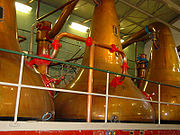
Pot still
Encyclopedia

Still
A still is a permanent apparatus used to distill miscible or immiscible liquid mixtures by heating to selectively boil and then cooling to condense the vapor...
used in distilling
Distillation
Distillation is a method of separating mixtures based on differences in volatilities of components in a boiling liquid mixture. Distillation is a unit operation, or a physical separation process, and not a chemical reaction....
spirits such as whisky
Whisky
Whisky or whiskey is a type of distilled alcoholic beverage made from fermented grain mash. Different grains are used for different varieties, including barley, malted barley, rye, malted rye, wheat, and corn...
or brandy
Brandy
Brandy is a spirit produced by distilling wine. Brandy generally contains 35%–60% alcohol by volume and is typically taken as an after-dinner drink...
. Heat is applied directly to the pot containing the wash
Wash (distilling)
In the production of distilled beverages, the term wash is used to refer to the liquid produced by the fermentation step, which is the input to the distillation process which concentrates the alcohol.-See also:...
(e.g. for whisky
Whisky
Whisky or whiskey is a type of distilled alcoholic beverage made from fermented grain mash. Different grains are used for different varieties, including barley, malted barley, rye, malted rye, wheat, and corn...
) or wine
Wine
Wine is an alcoholic beverage, made of fermented fruit juice, usually from grapes. The natural chemical balance of grapes lets them ferment without the addition of sugars, acids, enzymes, or other nutrients. Grape wine is produced by fermenting crushed grapes using various types of yeast. Yeast...
(for brandy
Brandy
Brandy is a spirit produced by distilling wine. Brandy generally contains 35%–60% alcohol by volume and is typically taken as an after-dinner drink...
). This is called a batch distillation
Batch distillation
Batch distillation refers to the use of distillation in batches, meaning that a mixture is distilled to separate it into its component fractions before the distillation still is again charged with more mixture and the process is repeated...
(as opposed to a continuous distillation
Continuous distillation
Continuous distillation, a form of distillation, is an ongoing separation in which a mixture is continuously fed into the process and separated fractions are removed continuously as output streams. A distillation is the separation or partial separation of a liquid feed mixture into components or...
).
At sea level, water boils at 100 degrees Celsius (212 °F) but alcohol boils at 78 degrees Celsius (172 °F). During distillation, the vapour is richer in alcohol than the liquid. When this vapour is condensed, the resulting liquid contains a higher concentration of alcohol. In the pot still, the alcohol
Ethanol
Ethanol, also called ethyl alcohol, pure alcohol, grain alcohol, or drinking alcohol, is a volatile, flammable, colorless liquid. It is a psychoactive drug and one of the oldest recreational drugs. Best known as the type of alcohol found in alcoholic beverages, it is also used in thermometers, as a...
and water vapour, combined with vapours of the multitude of aroma components such as esters, alcohols that give the mash or wine its aroma, evaporate and flow from the still through the condensing coil. There they condense to the first distillation liquid, the so-called 'low wines', with a strength of about 25-35% alcohol by volume, which then flows into a second still below. It is then distilled a second time to produce the colourless spirit, collected at about 70% alcohol by volume
Alcohol by volume
Alcohol by volume is a standard measure of how much alcohol is contained in an alcoholic beverage .The ABV standard is used worldwide....
. Maturation in an oak aging barrel typically causes the brown color to develop over time.
The modern pot still is a descendant of the alembic
Alembic
An alembic is an alchemical still consisting of two vessels connected by a tube...
, an earlier distillation
Distillation
Distillation is a method of separating mixtures based on differences in volatilities of components in a boiling liquid mixture. Distillation is a unit operation, or a physical separation process, and not a chemical reaction....
device.
The largest pot still in the world was in the Midleton Distillery constructed in 1825, County Cork
County Cork
County Cork is a county in Ireland. It is located in the South-West Region and is also part of the province of Munster. It is named after the city of Cork . Cork County Council is the local authority for the county...
Ireland. It had a capacity of 31,618 gallons (approximately 140,000 litres) and is no longer in use.
See also
- AlembicAlembicAn alembic is an alchemical still consisting of two vessels connected by a tube...
- Batch distillationBatch distillationBatch distillation refers to the use of distillation in batches, meaning that a mixture is distilled to separate it into its component fractions before the distillation still is again charged with more mixture and the process is repeated...
- Column stillColumn stillA column still, also called a continuous still, patent still or Coffey still, is a variety of still consisting of two columns invented in 1826 by Robert Stein, a Clackmannanshire distiller, and it was first used at the Cameron Bridge Grain Distillery in Fife, Scotland. The design was enhanced and...
- Pure pot still whiskeyPure pot still whiskeyPure pot still whiskey is whiskey distilled by a pot still. The term emphasizes that the whiskey contains only spirits produced from a pot still, without being blended with column still whiskey or neutral grain spirits...
- PoitínPoitínPoitín , anglicised as poteen, is a traditional Irish distilled, highly alcoholic beverage . Poitín was traditionally distilled in a small pot still and the term is a diminutive of the Irish word pota, meaning "pot"...

